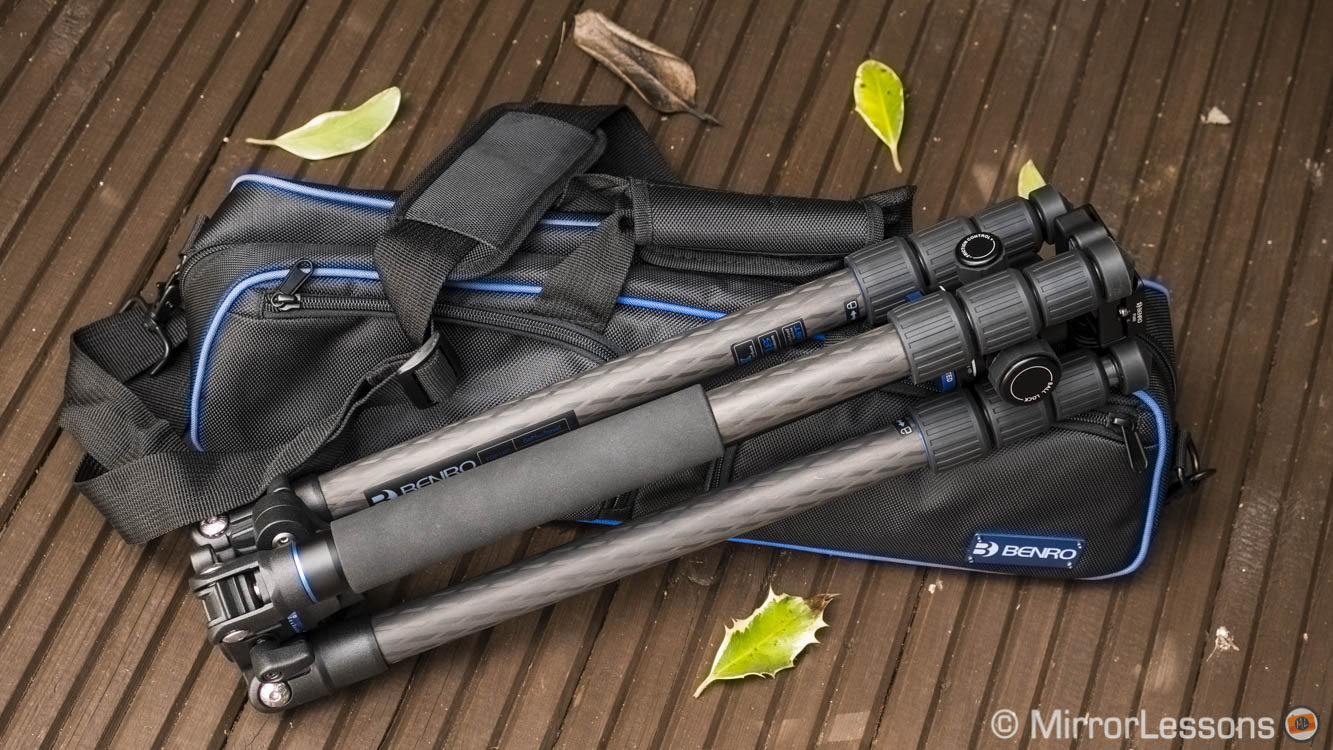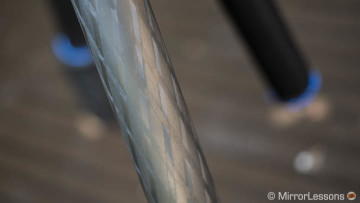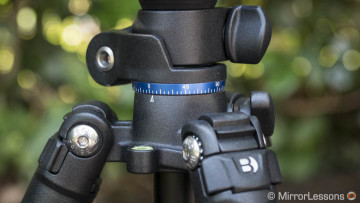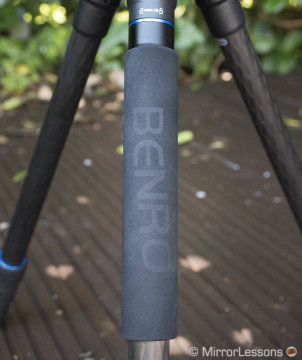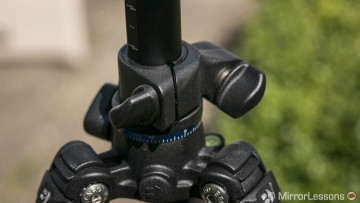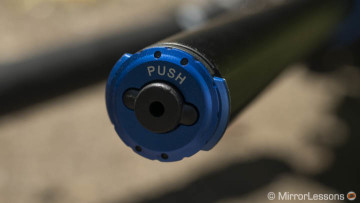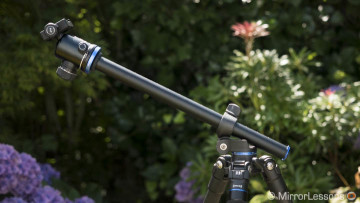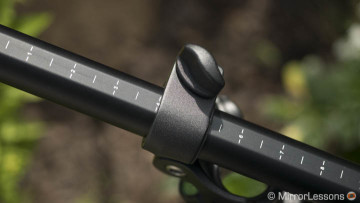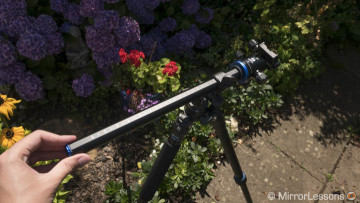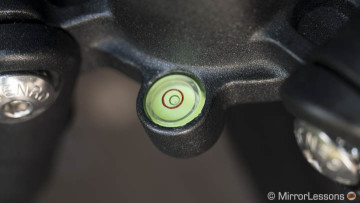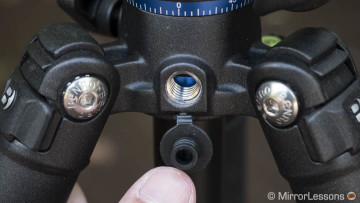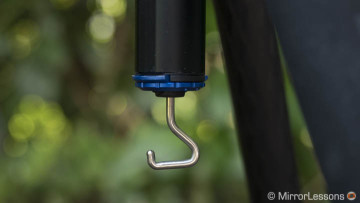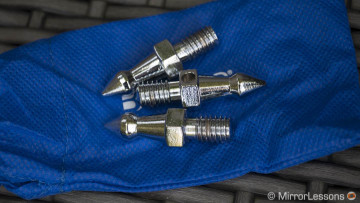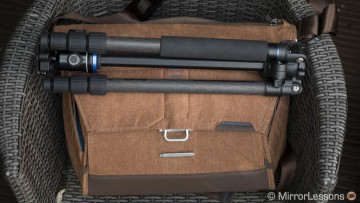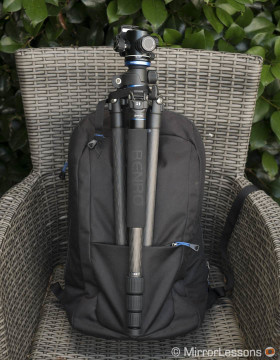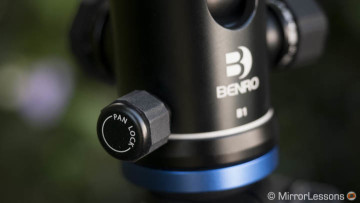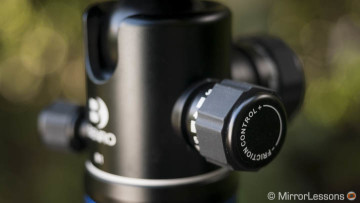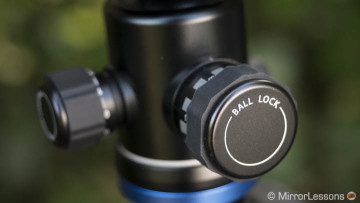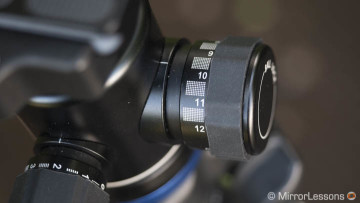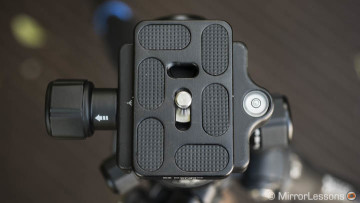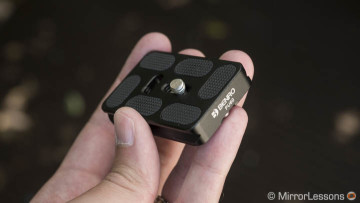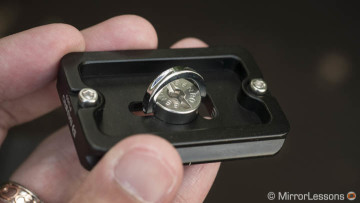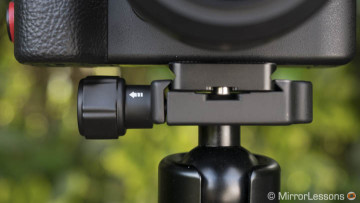Since starting MirrorLessons more than three years ago, we’ve reviewed almost every kind of accessory … except for tripods. There are a couple of reasons for this, the main one being the time and effort required to expand our professional network and receive samples from the various brands. On a more personal note, I admit that I’ve never been a big tripod aficionado. I only bring one with me when it is strictly necessary because I like to move about with as little gear as possible. The arrival of excellent image stabilisation on some mirrorless cameras didn’t help to change my mind either!
That being said, over the past three years, I’ve become aware of how important a role tripods play in a photographer’s workflow. Naturally they are essential for specific genres that require perfect stability such as long exposures but there’s more. They help you to compose more precisely and take the necessary time to carefully consider your composition. They also ensure more sharpness. Indeed, when you try an excellent tripod, you may have a hard time going back to the mediocre/cheap model you bought “just in case”.
So we decided it was about time to start integrating tripods into our accessory review list. We begin with a product that was announced only a few months ago at the Photography Show in the UK. The Benro Goplus Travel is the latest addition in the SystemGO family. It has been designed for photographers who are always on the move and provides a few extra options that make it versatile for all sorts of applications.

Main specs
- Code name: FGP18C / FGP18A
- Max. Load: 10 kg
- Max. height: 126 cm with 24° leg angle and column retracted, 154 cm with column extended
- Max. height monopod: 164cm
- Folded length: 46 cm
- Number of leg sections: 4
- Leg lock type: twist
- Independent leg spread: Yes-with 3 stops
- Center column: Versatile adjustable, swinging up to 180°
- Head mount thread size: 3/8″
- Material: carbon fibre, magnesium, aluminium
- Weight: 1.33kg
[toc heading_levels=”3″]
Design and build quality
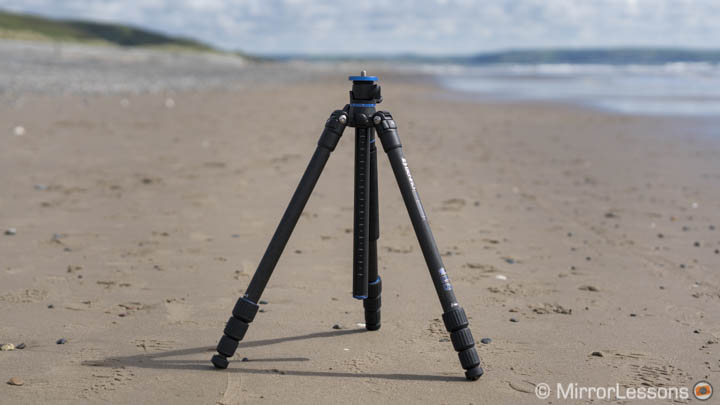
The Goplus Travel tripod is available in 4 different versions with the main differences being the number of leg sections, maximum height and maximum load capacity. The specific model I received for testing is the FGP18C where the letter C stands for Carbon Fiber. There is also an Aluminium version (FGP18A) that is slightly heavier. The FGP18C and FGP18A are the middle ground models: they’re not the tallest or the heaviest but they aren’t the smallest either.
The carbon fibre version has an excellent build quality and reasonable weight (1.33kg without the head) that makes it easy to carry around. When you see it for the first time, its size may deceive you into thinking that it’s heavy but once you lift it, you realise it is quite light.
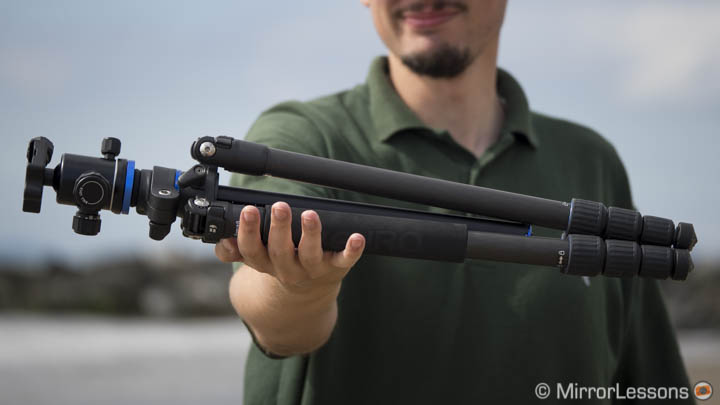
The legs are made from robust carbon fiber with an 8 layer design. The junctions with the centre column as well as the various knobs are made of magnesium alloy with anti-erosion painting treatment. The centre column is made of aluminium. On one leg (the one that can be detached and used as monopod) we also find a partial soft foam cover that adds extra comfort when handling the product. It also keeps your hands warm in the winter if you are not wearing gloves.
At the bottom you’ll find spiked feet made of solid rubber that screw into the legs directly. The screw is long so the chances of the foot unscrewing itself are minimal.
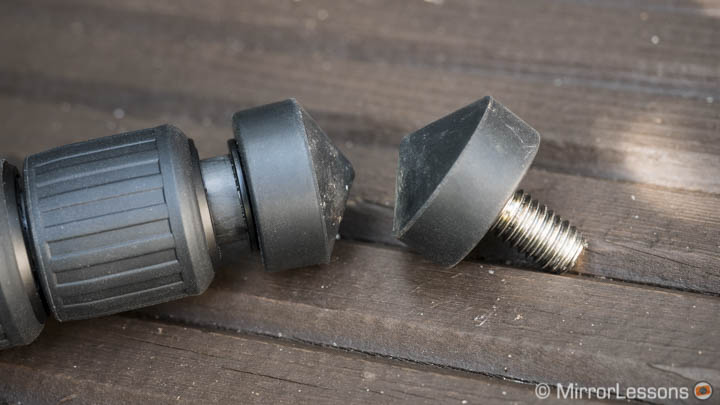
Rubber is also found on the quick leg locking rings for a better grip. The mechanism is dust resistant according to Benro so using the tripod in sandy conditions shouldn’t be an issue when extending or retracting the legs. This last point is quite important because my 2 year old Giotto Vetruvian VGRN9255’s locking mechanism is full of dust and often needs to be cleaned.
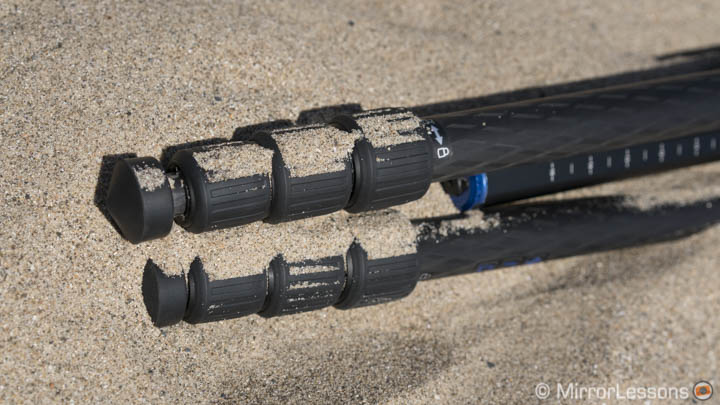
Since I wasn’t able to keep the sample for very long, I “simulated” a rough condition to see how the leg mechanism would resist to sand, which is one of the most common type of dust you’ll encounter when shooting landscapes. Overall I have to say they hold well. It is not perfect however as I found a few sand grains inside the smaller locks. To be fair to Benro, they specify that this dust resistance is an improvement over the previous models and should help to reduce the time needed to clean the legs.
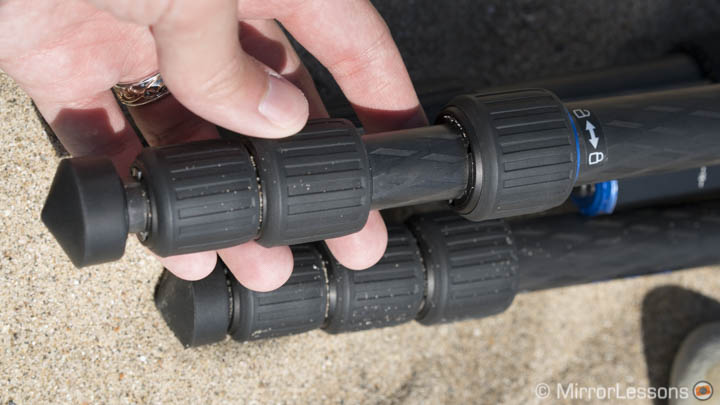
On the whole, I found the tripod to be sturdy and robust. I didn’t encounter any sort of vibration when taking long exposures unless I was shooting with a telephoto lens at the maximum height. In this case, the wind can cause some micro-vibrations, which is more noticeable if you record video samples, something that the tripod (and the head) is not really designed for.
Ease of use: legs and centre column
Twisting the leg lock rings by approximately 45° allows you to extend the height of the tripod. The twist mechanism is comfortable to use but the legs won’t extend automatically when holding the tripod in vertical position unlike other tripods I’ve used. This can slow you down a little if you are in a hurry but otherwise I don’t find it to be a concern. They might loosen over time.
The FGP18C model has 4 sections and reaches a maximum height of 126cm. With the centre column extended it reaches 154cm. If we add the head (10cm approx.) and the camera on top, the height is just below my eye level which is perfect for my needs (I’m about 190cm tall).
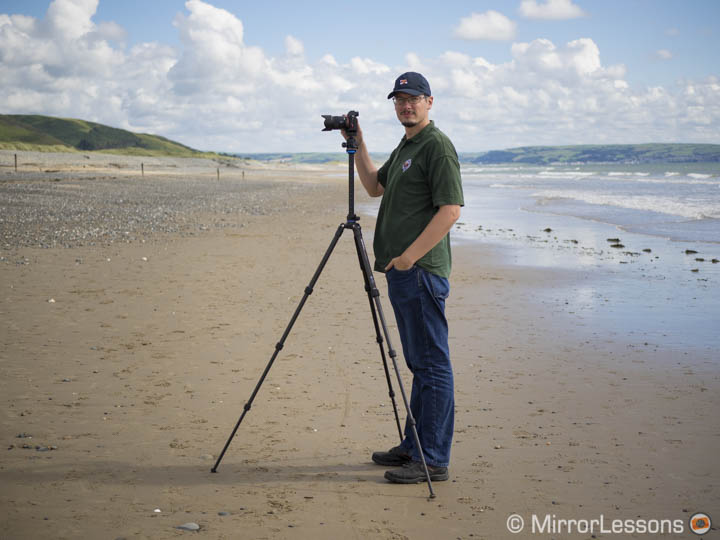
The centre column is what makes the GoPlus Travel so versatile.
If you extend the column to the top, loosen the column angle adjustment knob, then push the safety button, you can swing the centre column from its conventional position and lock it at any point down to 180°. Sliding the column back and forth and choosing a precise swing angle also helps you to frame your composition more precisely in addition to the axis of head. The centre column can also be rotated 360° on the horizontal plane which makes multiple configuration even easier to achieve. It also helps you to change a filter or a similar accessory and re-position the camera quickly if the tripod’s position makes the camera more uncomfortable to reach.
The swinging solution becomes useful for macro or other kind of shot taken from above. It allows you to get much closer to the subject you want to photograph or to choose certain angles that would be more difficult to achieve with a conventional tripod.
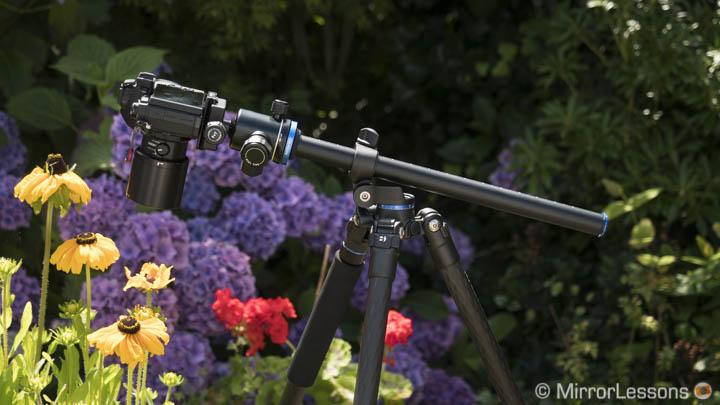

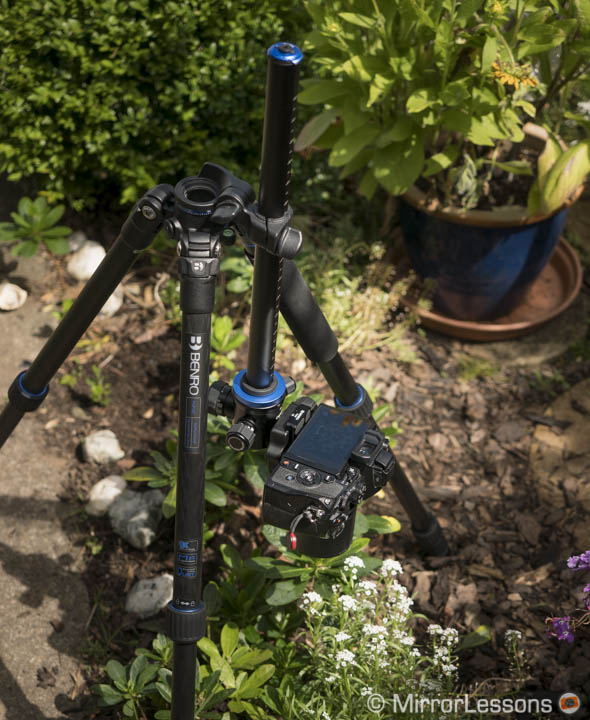

Naturally, the more you extend the column when in the horizontal position and the further away the camera/head is from the legs, the more you risk to unbalance the set-up, especially if you have a large camera and a large lens attached. The camera will also be more subject to vibration. Extending the height and angle of the legs can help maintain the gravity centre of the tripod. You can also reduced the length of a single leg to counter balance the weight.
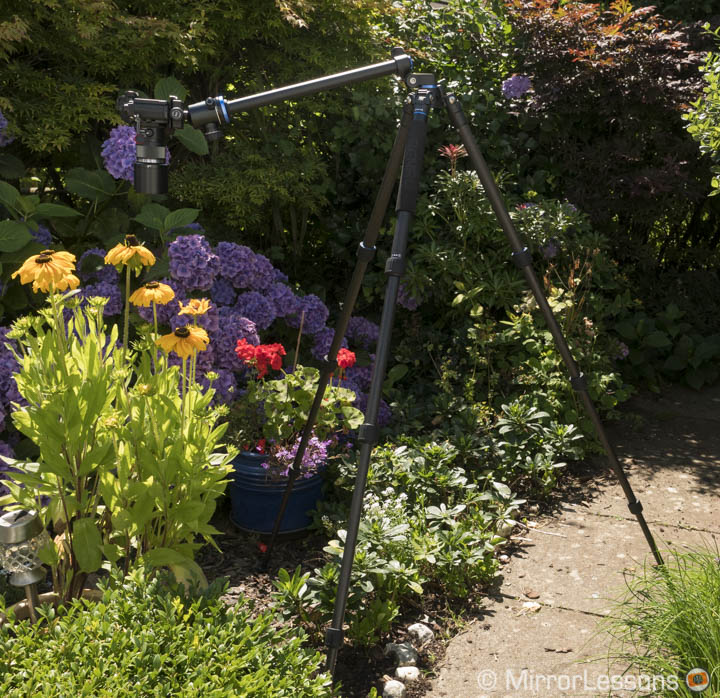
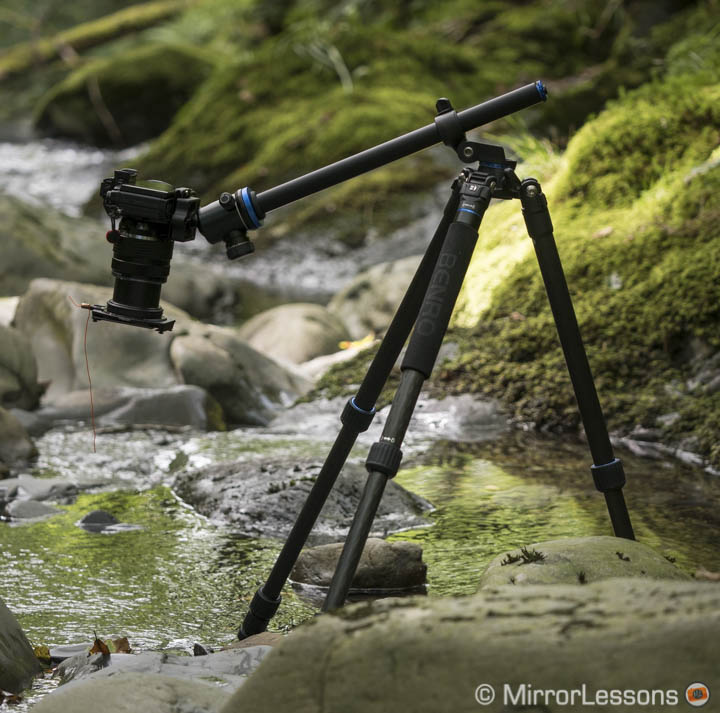
and counter-balancing the weight by reducing the length of one leg.

The legs have a manual angle adjustment lever that can be set to three different positions. The default position is the one seen above – it also gives you the highest configuration. The middle position allows you to keep the legs more spread out to reinforce the stability of the tripod.
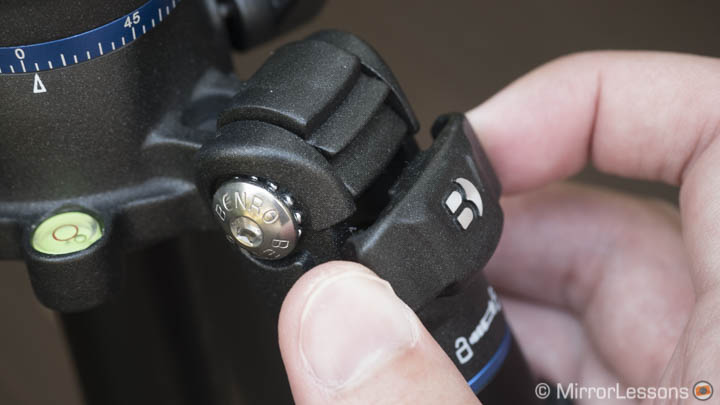
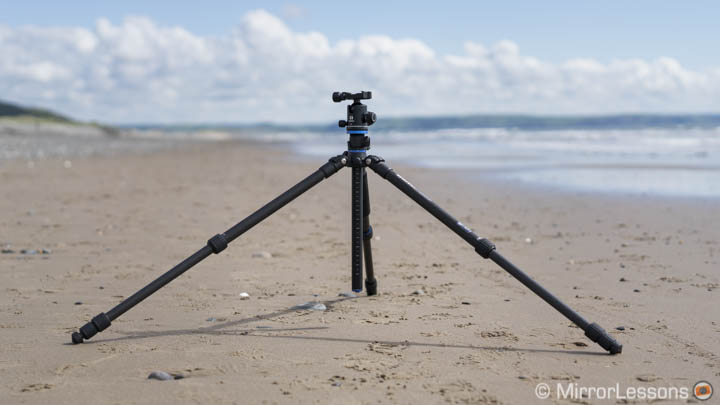
The third step, combined with the horizontal column position, allows you to place the camera at ground level.
Thanks to the swinging column and leg angle adjustment, the minimum height of this tripod becomes one of its strongest characteristics.
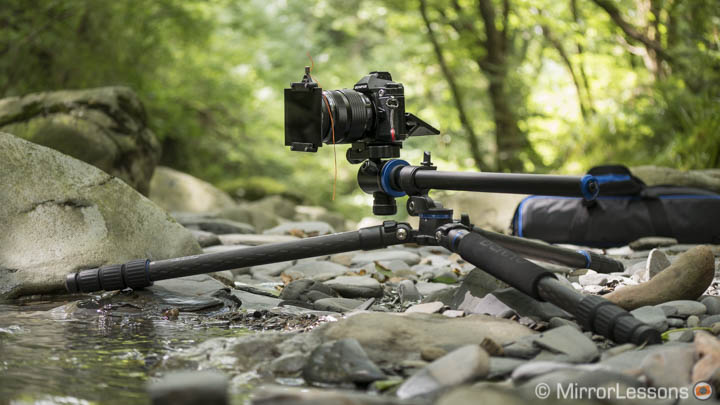

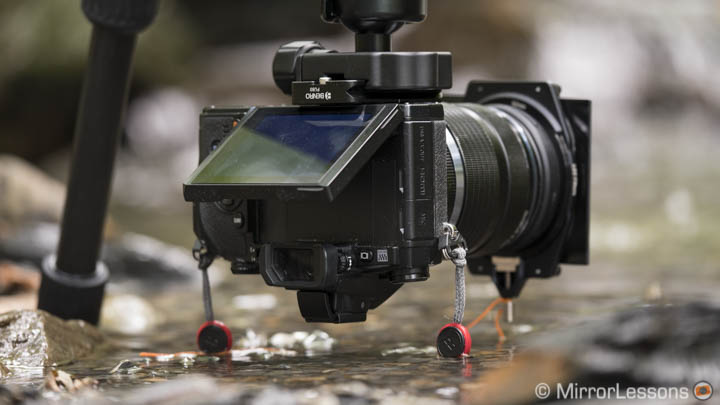

This is definitely one of the aspects I appreciated the most. Bring the camera to ground level with a conventional tripod is more difficult because the vertical column gets in the way. You either remove it and use a shorter one or find another solution. The GoPlus really makes a difference here.
So to summarise, the centre column position and orientation can be changed with three different knobs:
- the centre column locking knob will allow you to slide it vertically or horizontally
- the pan control locking knob will allow you to rotate the column 360° on the vertical axis
- the angle adjustment knob allows you to swing the column up 180°
It takes a few moments to familiarise yourself with these knobs but once you figure it out, setting the various configurations becomes easier. One of the only complaints I have regards the angle adjustment knob: it has a dented mechanism so you can’t fine-tune a precise angle, which can be more annoying when dealing with macro photography where every millimeter counts. It is also the least precise and most annoying knob of them all.
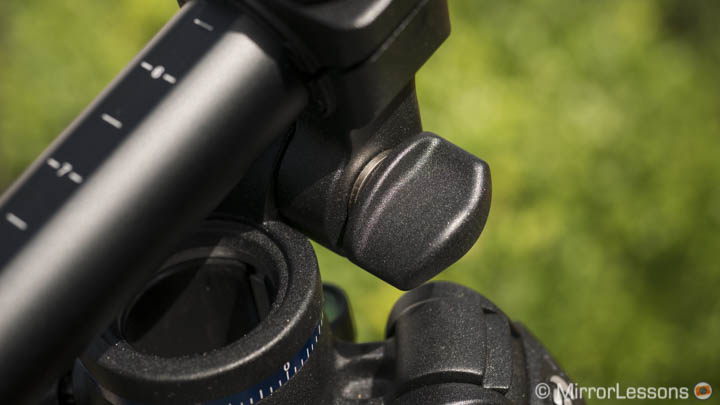
The second thing is that depending on the configuration, two of these knobs can end up being too close, thus acting as obstacles to one another, especially if you tighten the Pan knob to the max. So when setting the tripod, make sure that these two knobs aren’t close together.
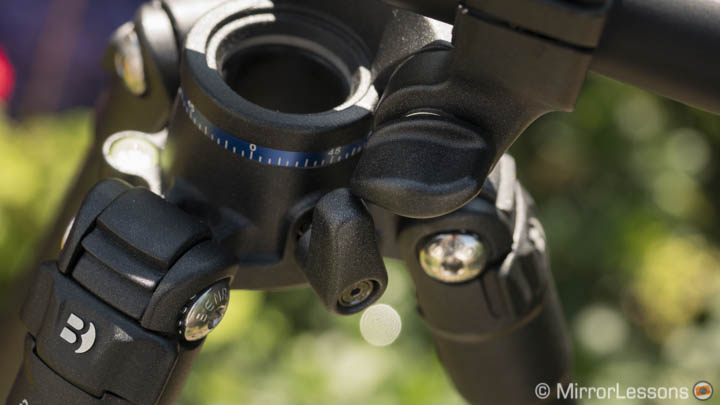
On a final note, one of the legs can be detached, connected to centre column directly and used as a monopod. Additionally, you can also purchase the optical wooden handle and use it as a stick which is a cool idea if you feel tired at the end of your hiking journey!

Ease of use: extra options
There are a couple of extra features worth mentioning about this tripod. You can find a bubble level on the tripod, in addition to the one on the head (assuming the specific head used has one). There is a 3/8” accessory mount on the side that allows you to connect extra accessories like a small field monitor or similar photo/video equipment (you might need an articulated arm or similar mounting tool as well).
At the bottom of the centre column you can screw on a hook (provided) to hang extra weight and stabilise the tripod even more. If you don’t fancy rubber spiked feet, metal versions are included in the package.
There are also extra accessories designed to be used with the centre column in the horizontal position. For example the GSC100 GoCoupler 1 allows you to attach a ballhead in its natural position (vertical) or to attach an extra head if you want to have two cameras side-by-side. With the GSC190 GoCoupler 1 you can attach an addition column. This gives you an idea of the additional set-ups you can create with this tripod.
Ease of use: transportation
The legs can be reversed, folded and wrapped around the centre column and head which reduces the length and provides a more compact unit for transportation. Once folded the length becomes 46cm which fits most max. dimensions for cabin luggage. This means it can be carried inside a bag or small trolley if you are traveling by air and don’t want to leave your tripod in the hold. Please always check these specifications with the specific company you are travelling with as not all of them have the same restrictions.
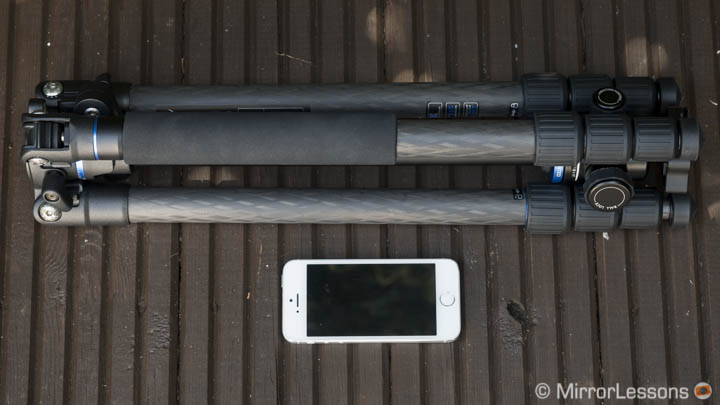
With the tripod, Benro includes a padded carrying bag complete with a hand and shoulder strap plus two handy external pockets. I find it very comfortable and I used it more than once to carry the tripod separately when I had a small camera bag with me.
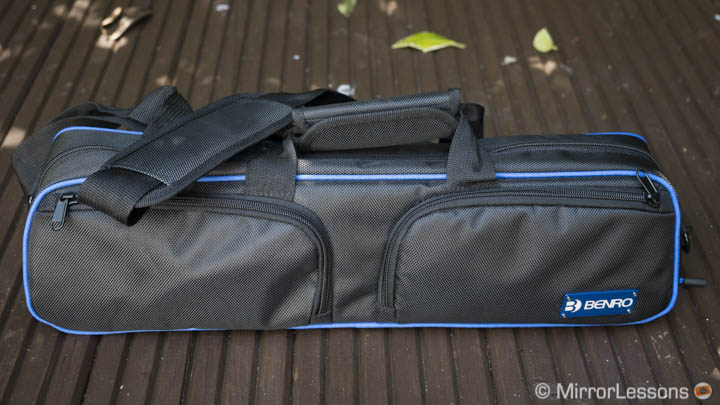
Some camera bags are equipped with inserts to attach tripods directly. The best bag for the job out of the ones I’ve tested recently is the Peak Design Messenger bag because it is large and fits the length of the folded tripod well. On the ThinkTank Perception 15 shoulder bag, it is a little too long and if you lay the bag on the ground it will inevitably fall over. On smaller bags like the Tenba Switch, it becomes too large and uncomfortable.
Tripod head used: Benro B1
The head sent to me with the tripod is the B1 model and is part of the B series. Note that as of now, the tripod is sold standalone without any head so I will only talk briefly about the B1. In the future, the MacGroup distributor might consider adding a kit with the tripod and a head.
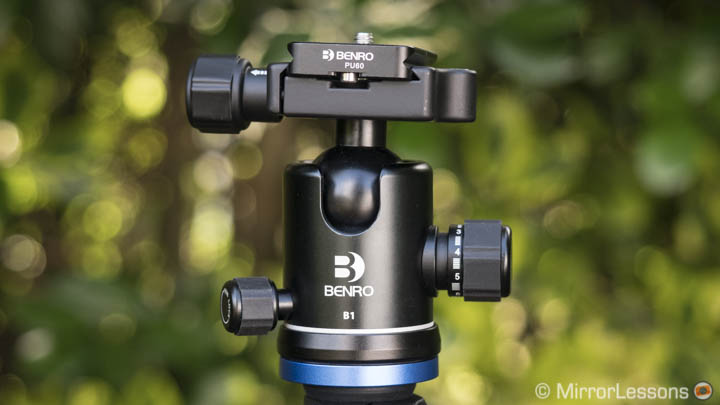
The B series’ main characteristic in comparison to other Benro ball heads is the independent friction control in addition to the locking and panning knobs. The head mount thread size is 3/8″ so you can easily mount a third party head if you already own a compatible one.
The B1 head supports a maximum load of 14kg which is actually superior to the one of the tripod (10kg). It comes with a bubble level. The independent friction knob is useful and the head secures the camera’s position very well. Both friction and lock mechanisms have markings indicating the strength selected. However they are useless because the knobs turn more than they should so you easily lose the correct marking. It is better just to go by feeling.
On top you’ll find a bubble level. The plate is an arca swiss type which makes the head compatible with a variety of products including the gear from Peak Design which I personally use a lot. The locking knob has a two-step mechanism to ensure safety. It is very close to the bottom of the camera once the latter is attached, which can make the unlocking operation a little bit uncomfortable.
Series overview, price and recommended mirrorless systems
The GoPlus series is part of Benro’s SystemGO tripod family and is the most recent addition. It consists of two main models: Classic and Travel. The main difference between the two is that the legs on the Travel version can be reversed and folded to reduce the length. This isn’t possible with the Classic version. Each main model has four versions that vary according to max. height, load and leg sections. You will also find carbon fiber and aluminum versions.
If you search on the internet, you might stumble upon the GoTravel and GoClassic tripods which are the previous models and are mostly sold in the US. The difference with the GoPlus is the centre column that can only be swung 90° (the angle mechanism is different). All the other specifications including build quality and other options remain the same.
The GoPlus Travel FGP18C is priced at almost £300 while the aluminum version is much cheaper at less than £150. Since the difference in weight is not huge, go with the aluminum version if you want to save some money and perhaps invest in a better head. The B1 head costs around £100. The tripod is available across Europe and is distributed in the UK by MacGroup. The same distributor should also bring the new product to the US in the future.
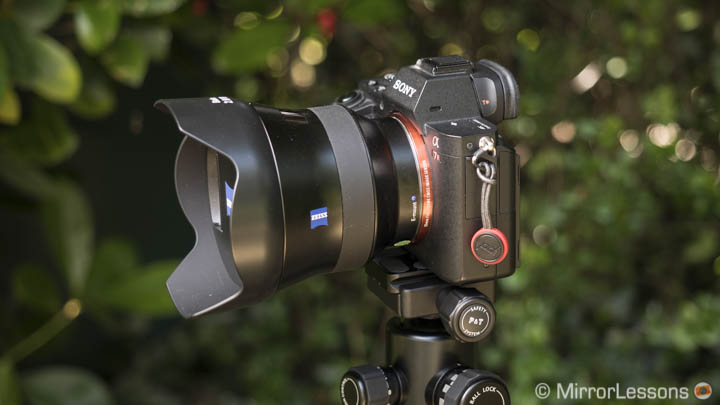
I tested the tripod with the A7r II / OM-D E-M1 and various lenses. I would recommend using it with a high-end mirrorless model and large lenses regardless of the system. (It is designed to be used with DSLR equipment as well.) To give you a few examples, a combination like:
- A7r II with Batis 18mm, 35mm 1.4 or 16-35mm f/4
- X-Pro2 or X-T2 with 10-24mm, 16-55mm
- OM-D E-M1 with 7-14mm, 12-40mm or 40-150mm
The tripod is a little large for smaller cameras like the Lumix GX80 with a pancake lens attached for example.
Conclusion
The thing with tripods is that you are never sure how good they are until you have used them extensively for at least four or five months to check their durability. When you unbox them brand new, they always look perfect and the first weeks of use won’t necessarily reveal any flaws.
In the case of this tripod, it was the first Benro product I had the chance to try and I can say it left me with a positive impression. The build quality is excellent and the carbon fiber material makes it light and easy to carry around. The twisting leg lock mechanism is comfortable to use and the maximum height is more than enough for my needs.

The real advantage is the centre column. By swinging it 90° or 180°, you can use the tripod at a very low level or shoot objects from above. When you think that all this is included in a package that is travel friendly, there is little to complain about.
As of now, the head is sold separately meaning that using the tripod requires two investments. The head is as important as the tripod itself and while the B1 proved robust and stable, I found the lock and friction controls somewhat annoying in operation.
 What I like about the Benro GoPlus Travel (FGP18C):
What I like about the Benro GoPlus Travel (FGP18C):
- Solid construction and robust design
- Middle ground size and max. height that makes it useful for most applications
- The twisting centre column adds lots of versatility
- Monopod option
- Possibility to attach other accessories
- Handy carrying bag
 What I don’t like about the Benro GoPlus Travel (FGP18C):
What I don’t like about the Benro GoPlus Travel (FGP18C):
- The leg lock mechanism is not completely dust resistant meaning some cleaning might be required over time
- The swinging angle knob for the centre column is annoying to operate
- Kit isn’t sold with the head as of now
 To consider:
To consider:
- The carbon fibre version is much more expensive than the aluminium version and the difference in weight (judging from the specs) is not huge
- A cheap head on this kind of tripod won’t do the job so consider investing in a good one
